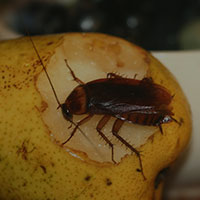Cockroach Control and Extermination
Cockroach control is challenging due to the roaches' resilient nature. Cockroaches can survive, and thrive, just about anywhere.
Croach® is especially skilled in the identification, management, and elimination of cockroaches. We thoroughly inspect all areas of your home, discuss our findings, and customize an action plan to eradicate the current pest population and prevent future infestations.
Cockroach Control Services Near You
Get a Croach® pest exterminator near:
- Seattle (including Mukilteo, Sumner, Kirkland, Tacoma, Mount Vernon) and Tri-Cities, Washington.
- Spokane, Coeur d'Alene, Lewiston, and Boise, Idaho.
- Portland, Beaverton, Oregon.
- Denver, Aurora, Colorado.
- Columbia and Greenville, South Carolina.
- Salt Lake City/Sandy, Utah.
Free Pest Inspection
Do I Have a Cockroach Problem?

Roaches are one of the oldest pests around, predating even humans. There are more than 4,000 species, but the German cockroach is the most prevalent in households.
If you see even a single cockroach in your home, you very likely have a roach problem.
They are social insects. German cockroaches, specifically, leave a fecal trail, the odor of which attracts others to their hiding places and food sources. Though they can survive in freezing temperatures, they prefer the warmth of the indoors.
Do you need the help of a cockroach control technician? Here’s what to look for:
- Fecal Droppings. Check behind your large appliances, sinks, and any place food is stored. Depending on the type of cockroach, the feces you find may resemble tiny specks of pepper, brown stains, coffee grounds, or oval pellets.
- Egg Casings. When the eggs hatch, a brown, oblong casing or ootheca (egg case) is left behind. A German cockroach egg casing can contain up to 50 eggs. Look for casings behind furniture, inside cracks, or in any out-of-sight, protected area.
- Odor. Smelling something musty and oily? Roaches produce a distinct lingering odor. Just one German cockroach can produce this smell on its own. If the scent is noticeable, you have a cockroach infestation.
- Dead Cockroaches. Look for dead roaches under your sinks, in cabinets, or under your stove or refrigerator.
- Cockroach Sightings in the Daytime. Roaches are nocturnal and avoid light. However, overcrowding or competition for food leads to cockroach activity during the day; a sure sign they have a stronghold in your home.
Why Are Roaches in My Home?
If you have roaches, it does not mean your home is unclean or untidy. But, consider the following sources as invitations to cockroaches to create a habitat.
- Food and Water. Accessibility to human food, pet food, cardboard food containers, unsealed food packaging, leaky faucets, and even pet water dishes attract cockroaches.
- Garbage. Trash cans, recycling bins, and the garbage disposal in your sink.
- Neighbors. If you share a wall or other connecting structure (such as in an apartment, condo, or townhome), you may also share any roach troubles your neighbor has.
- Clutter. Cockroaches love paper and cardboard in dishevelment. Unattended storage of newspapers, boxes, or books are great places to take up residency and avoid being seen by you.
Roaches also enjoy eating the glue in book bindings, on the back of stamps, or on wallpaper.
Related Article: How are Roaches Getting in my House?
The Dangers of Cockroaches as Roommates
Cockroaches will eat almost anything that contains nutrients. Roach infestations damage furniture, wallpaper, clothing, cardboard, books, and anything made with natural materials.
But the biggest danger of a cockroach invasion is to your health. It's important to seek the help of a cockroach control professional immediately to avoid the following dangers:
- Allergies. Skin rashes, sneezing, watery eyes, nasal congestion, ear infection, sinus infection, and wheezing are some of the allergic reactions associated with cockroach infestations. Studies show that up to 50% of people are allergic to the protein in roach saliva, cast skins, and droppings. You probably won’t know you have an allergy until it’s too late.
- Asthma. If someone in your home has asthma, an infestation can cause flare-ups and severe complications if left untreated. The Asthma and Allergy Foundation of America warns of allergic reactions and the dangers of cockroach exposure to those with asthma.
- Salmonella. Carried by cockroaches, this can cause Typhoid fever, gastroenteritis, and dysentery.
- Polio. Cockroaches carry the bacteria Poliomyelitis.
- E. Coli. Roaches can pass along a nasty strain of Escherichia coli bacteria.
- Enterococcus. Cockroach-contaminated objects can cause Meningitis and urinary tract infection.
- Parasitic Worms and Pathogens.
Cockroach Extermination Services By Croach®
The only way to end a cockroach problem is to eliminate every roach. That's why our skilled Cockroach control technicians leave no stone unturned. We inspect every cranny and crevice in your home to ensure we find and treat every nest.
Roaches breed quickly, producing thousands of bugs every cycle. That's why we set you up with a regularly scheduled treatment plan. Our technicians regularly return to disrupt Cockroach breeding cycles, using our eco-friendly treatments to create a protective barrier around your home.
Cockroaches will never stop trying to enter our homes. But you can keep your cockroach problem under control for good through our prevention and extermination services.
The Croach® Pest Control Guarantee
We guarantee 100% satisfaction. If you're not completely satisfied with our cockroach control services, or you see pests in between regular treatments, call us for a no-questions-asked retreat free of charge. If we can't fix the problem after two retreats, we will refund your last full payment. We're that confident we can keep your cockroach problem under control.
Never try to manage a roach infestation alone. Over-the-counter products aren't strong enough and can be hazardous to your health. Turn to the cockroach control experts who handle infestations fast. Turn to Croach® today.
Free Pest Inspection
